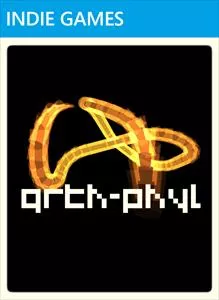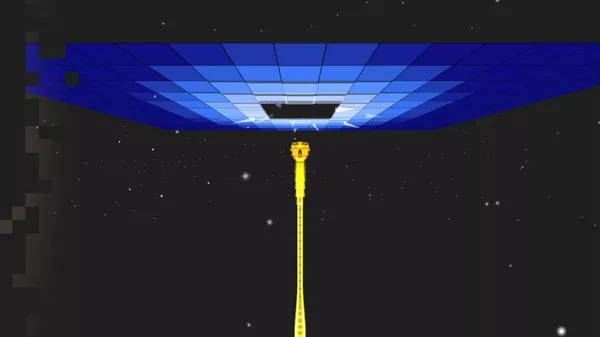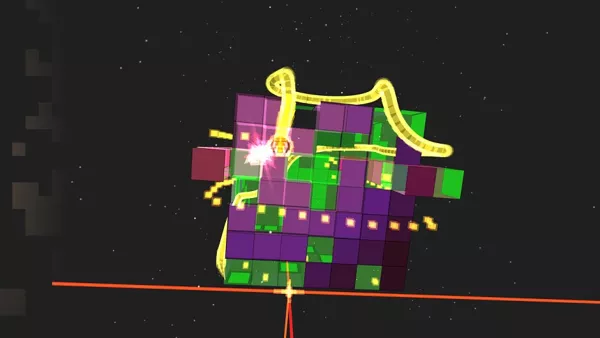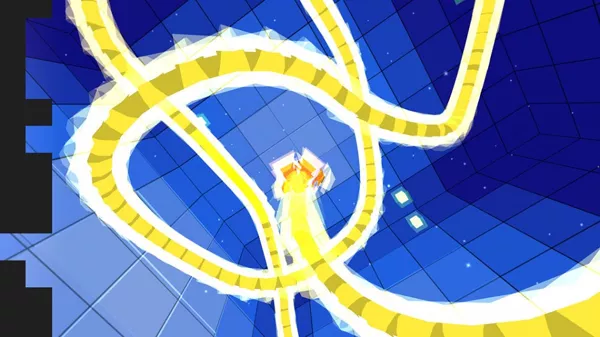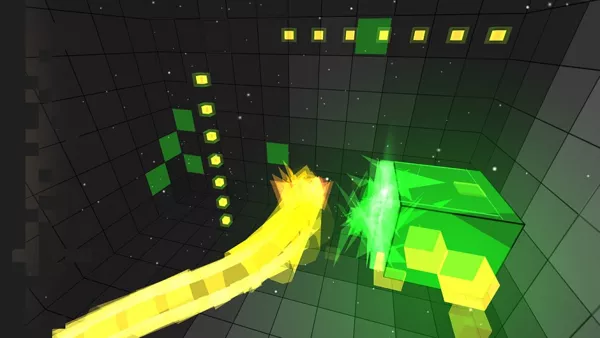qrth-phyl
Description
qrth-phyl is a tridimensional development of the classic game of Snake. It continues the game design concept of Leave Home. There are surface levels — played on the whole surface of squares, rectangles, and parallelepipedes — and internal levels, inside parallelepipedes. The player is in control of a snake; the aim of the snake is survival, without other purposes. Survival requires to eat an assigned quantity of dots for an exit to next level to appear. Death occurs if the head of the snake comes into collision with its own body (metaphorically signifying the need «to avoid the past»), or any other object.
Obstacles and menaces additional to the body consist of:* Lasers (introduced by a warning sound effect and extending throughout level, always coming in a couple of orthogonal ones);
- Fixed blocks (single or in arrays);
- Single blocks that materialize for a lapse of time (introduced by a warning sound effect);
- Arrays of blocks which move as the snake;
- Columns of blocks, as long as the height of internal levels, which enter these, vertically cross them and disappear;* Game area surface, in internal levels.
While eating dots, the snake grows in length, its body becoming harder not to collide with; it returns to its initial size on next level, or after the loss of a life. The main game mode is Sequence: first level is on a plane surface, and thereby there is a one-and-one alternation of internal and surface levels. The snake has four lives; the sequence is indefinite till death.
All of the gameplay elements — level type succession, dot appearance and position, non-fixed obstacles quantity and behaviour — are generated at random and adaptively. A gamer able to collect more dots or advance without losing a life or play swiftly will meet more hardships. Game code is self-generative, and adaptation varies each installation as well as during each game. Electronic sound is generated at random and adaptively as well, with a sound effect mirroring the snake's movement by distortion.
Combination of obstacles and dangers with internal or surface levels and their shape and size leads to ten types of levels in all, five Out and five In. Levels are parted into squares. Whereas close areas are well visible, others are less, and more distant ones are not visible: this represents the view of the snake, and, through light effects making the lively colour tints changeable, in co-operation with electronic sound, renders a psychedelic environment. New dots appear as present ones are gathered; their total for a level exceeds the quantity required to advance to the following, allowing the quest for high scores, but while permanence in a level is prolonged difficulty rises, as the snake continues to lengthen. A bonus item dematerializes for a second the snake's body into its trajectory, placing extra dots all along its course. Back to normality, dots are there to be collected to ease level progression and raise the score.
Elements is the score attack mode. All level types reached in Sequence mode are playable singularly. Unlike main game mode, each game takes place in only a level, dots appear endlessly, one life is given to the snake, and its increasing lenght augments chance for game over till inavoidability. For each level type, number of visits, completions, and highest score are recorded. There is also an overall percentage of corruption, its increase reflecting how long and how well the game has been played. During game play, on the left side of the screen a graphic effect representing entropy («corruption») intensifies as the snake continues to live: this has a metaphorical-only value, with no influence on gameplay. Also metaphorically there are no continues.
Gameplay hinge is different in Out and In levels: in the former the central worry is to avoid the snake's body: stage by stage the minimum or required dots raises, making it easier for the snake to stumble upon its body. In the latter, the primary problem are lasers and moving objects, while moving within a volume lowers chance the snake meets its body.
The score system is centred on a combo system. Gathering a dot awards 1 point. If a dot is collected within short time another one was, 1 additional point is awarded. The fifth quickly gathered dot will for example earn 5 points. While this applies, dots flash; once they stop flashing the score given by a newly collected dot will be lower than the last one, but not necessarily 1, as accumulated combo streak reduces gradually.
The snake can move at a standard or a faster pace: the latter is intended to reach more dots while they are flashing for hi-score purposes, to move past a point before lasers (momentarily) block the way, and, since an extensive use of it elicits harsh response from the game, to raise difficulty by will.
Groups +
Promos
Credits (Xbox 360 version)
10 People (6 developers, 4 thanks)
| Game by | |
| Thanks |
|
| References |
|
Reviews
Critics
Average score: 80% (based on 1 ratings)
Trivia
Origins and development
qrth-phyl descends from a prototype realized in 2004. The released version was the result of two years of re-development. The author used custom tools, self-generating code, and a modified AY-3-8912 audio chip.
PC version bonuses
The PC version of the game includes the original unreleased 2004 game prototype, the original Blockade service manual and Random Illogic and Elegant Creeps, an article by Lane Hauck, the author of Blockade.
Analytics
Upgrade to MobyPro to view research rankings!
Related Sites +
-
qrth-phyl
project page on the developer's website
Identifiers +
Contribute
Are you familiar with this game? Help document and preserve this entry in video game history! If your contribution is approved, you will earn points and be credited as a contributor.
Contributors to this Entry
Game added by is_that_rain_or_tears.
Additional contributors: Alsy.
Game added January 23, 2014. Last modified June 25, 2023.
